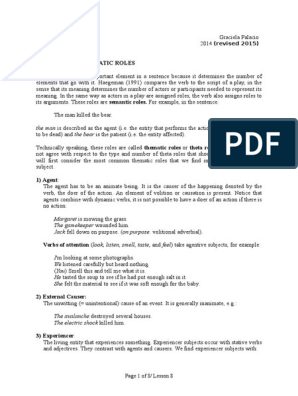unit 4: Predicate Argument Structure, Meaning representation systems, Software
Predicate Argument Structure:
-Predicate-argument structure, also known as semantic role labeling, is a method used to identify the
roles of different parts of a sentence.
-The "predicate" is usually a verb (but can also be a noun, adjective, or preposition), and the
"arguments" are the entities that participate in the action or state described by the predicate.
Resources:
-These resources help computers understand the meaning of sentences by identifying the action and
who is involved.
-This is important for things like translating languages, answering questions, and even helping virtual
assistants understand commands better.
(i) Framenet
(ii) PropBank
FRAMENET:
FrameNet looks at how words are used in different situations (frames) and identifies the roles that
other words play in these situations.
It is based on the theory of frame semantics, which suggests that the meaning of a word can be
understood in terms of the typical situations it describes.
Key Elements:
Frames: A frame is a type of situation or scenario. Each frame involves certain participants, which are
called frame elements.
Frame Elements: These are the roles played by the different participants in a frame.
Lexical Units (LUs): These are pairs of words and their meanings (frames). Each lexical unit is a
specific meaning of a word in a given frame.
Think of the word "break" in two different frames:
Frame 1: "Break" as in breaking a rule.
Roles:
Breaker (the person who breaks the rule)
Rule (the rule being broken)
Frame 2: "Break" as in breaking an object.
Roles:
Breaker (the person who breaks the object)
Object (the thing being broken)
Working:
1. Identify Frames: Researchers identify common situations (frames).
2. Assign Frame Elements: Each frame has specific roles.
3. Label Sentences: Sentences are tagged with these frames and frame elements to show how
words are used in context.
Example:
Frame: COMMERCE_BUY
Sentence: "John bought a car from Mary for $20,000."
� Frame Elements:
Buyer: John
Goods: a car
Seller: Mary
Money: $20,000
PROPBANK:
-PropBank is a corpus of texts where each verb is annotated with its arguments, giving us a clear idea
of who is doing what to whom in a sentence.
-This helps in understanding the roles of different entities in relation to the verb.
Key Elements:
Predicate: Usually a verb, it represents an action or state.
Arguments: The participants involved in the action or state described by the predicate. Arguments
are categorized as core (essential to the meaning of the predicate) or adjunctive (providing additional
information).
For the verb "operate":
Sentence: "The doctor operates the machine."
Roles:
Operator (who is operating, e.g., "The doctor")
Thing being operated (what is being operated, e.g., "the machine")
Working:
1. Annotations: PropBank annotates verbs in the Wall Street Journal section of the Penn Treebank.
Each verb is tagged with its core arguments (like the subject, object) and adjunctive arguments (like time,
location).
2. Framesets: Each verb has a frameset that lists possible argument structures (roles) it can take,
along with descriptions of these roles.
Example of PropBank Annotations
Sentence: "John gave Mary a book."
Predicate: gave
Arguments:
ARG0 (Agent): John (the one who gives)
ARG1 (Theme): a book (the thing given)
ARG2 (Recipient): Mary (the one who receives)
In PropBank notation, this might be represented as:
[ARG0 John] [gave] [ARG2 Mary] [ARG1 a book].
Core Arguments:
These are essential participants directly involved with the predicate:
ARG0: Typically the agent or doer of the action.
ARG1: Typically the patient or theme (the entity undergoing the action).
ARG2, ARG3, ARG4: Other roles that vary depending on the verb’s meaning.
Adjunctive Arguments:
These provide additional information about the action and are labeled as ARGM-XYZ, where XYZ
�indicates the type of information:
ARGM-LOC: Location (e.g., "in the hotel")
ARGM-TMP: Time (e.g., "yesterday")
ARGM-MNR: Manner (e.g., "quickly")
ARGM-CAU: Cause (e.g., "because he was hungry")
ARGM-DIR: Direction (e.g., "to the store")
ARGM-PRP: Purpose (e.g., "to buy groceries")
ARGM-NEG: Negation (e.g., "not")
ARGM-MOD: Modality (e.g., "can," "might")
Example of a Complex Annotation:
Sentence: "The company operates stores mostly in Iowa and Nebraska."
Predicate: operates
Arguments:
ARG0 (Agent): The company
ARG1 (Theme): stores
ARGM-LOC (Location): mostly in Iowa and Nebraska
OTHER SYSTEMS or RESOURCES OF PREDICATE ARGUMENT STRUCTURE:
1. NOMBANK
2. VERBNET
























































































